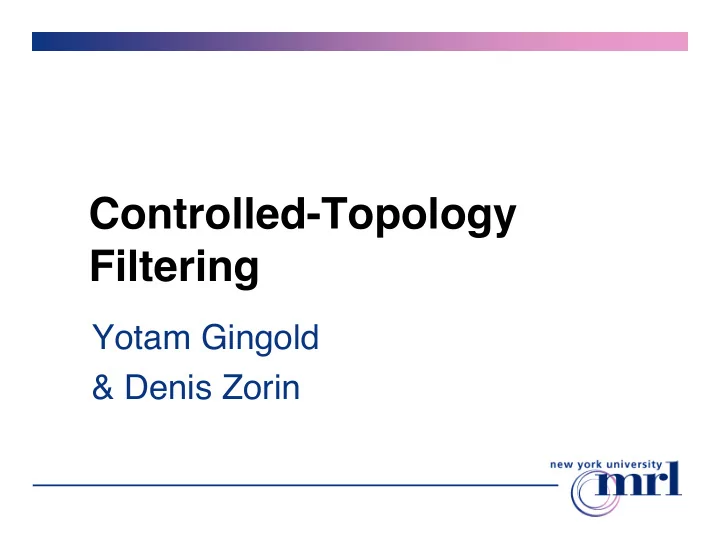

Controlled-Topology Filtering Yotam Gingold & Denis Zorin
Motivation Many applications require extraction of isolines & isosurfaces (contours) from scalar functions MRI, CT, terrain data, scientific computing Cow CT Scan Puget Sound
Motivation Want to filter (smooth, sharpen) all contours at once Downsampling Noise reduction
Contour-line topology Number of contours at all isovalues In 2D fields, value can be height Topology changes occur when value equals value of a critical point (min, max, saddle)
Critical Points Maxima and minima correspond to hills and valleys Saddles join two hills or valleys
Features Correspond to critical contours passing through saddles A saddle divides a contour in two The interior of a contour containing an unpaired extremum is a feature
Topological Events Features appear/disappear in saddle-min/max pairs
Piecewise linear data Scalar values defined on a regular grid Simplicial mesh guarantees critical points only at vertices Some complex critical points can be stable
Piecewise linear data Find critical points by comparing value with neighbors saddle saddle regular min max (simple) (monkey) Break ties with arbitrary, consistent perturbation
PL topological events Only happens when 2 adjacent vertices change relative height The edge flips relative to equality 1D
PL topological events Merge/Split Move Nothing
Laplacian Smoothing
Laplacian Smoothing Can create features Ridge Bridge blood vessels as in
Ridge Bridge (t = 0.0)
Ridge Bridge (3.5)
Ridge Bridge (7.0)
Ridge Bridge (10.5)
Ridge Bridge (14.0)
Ridge Bridge (17.5)
Ridge Bridge (21.0)
Ridge Bridge (24.5)
Ridge Bridge (28.0)
Ridge Bridge (28.0) 2/3
Ridge Bridge (28.0) 3/3
Puget Sound (3.5)
Puget Sound (8.4)
Puget Sound (13.3)
Puget Sound (18.2)
Puget Sound (23.1)
Puget Sound (28.0)
Puget Sound (32.9)
Puget Sound (37.8)
Puget Sound (42.7)
Puget Sound (42.7) 2/3
Puget Sound (42.7) 3/3
Anisotropic Smoothing Can also create features
Sharpening Don ’ t want to create or destroy features
Algorithm 1. Obtain proposed values from the filter function 2. Identify edge flips and sort in time 3. Detect and prevent disallowed events 4. Goto step 1
1. Obtain proposed values Current Filter values at function Proposed step l values at Step size step l+1
2. Identify flips and sort Function values change linearly from to An edge between adjacent vertices flips at most once Must resolve flip time exactly Otherwise vertex ordering becomes cyclic Every vertex has a unique epsilon perturbation value 0 t 1
3. Detect & prevent disallowed events Process events in order If we reach a disallowed event between vertices , set to values infinitesimally before the event value 0 t 1 0 t 1 Must re-identify events involving v,w May need to rewind the event queue
3. Detect & prevent disallowed events 1D: 2D:
Algorithm 1. Obtain proposed values from the filter function 2. Identify edge flips and sort in time 3. Detect and prevent disallowed events 4. Goto step 1
Results: Ridge Bridge (0.0)
Results: Ridge Bridge (3.5)
Results: Ridge Bridge (7.0)
Results: Ridge Bridge (10.5)
Results: Ridge Bridge (14.0)
Results: Ridge Bridge (17.5)
Results: Ridge Bridge (21.0)
Results: Ridge Bridge (24.5)
Results: Ridge Bridge (28.0)
Results: Ridge Bridge (28.0) 2/3
Results: Ridge Bridge (28.0) 3/3
Results: Laplacian Smoothing uncontrolled original suppressed controlled
Results: Laplacian Smoothing uncontrolled original suppressed controlled
Results: Sharpening uncontrolled original suppressed controlled
Results: Sharpening uncontrolled original suppressed controlled
Results: Anisotropic Smoothing uncontrolled original suppressed controlled
Local artifacts Due to slowing time uncontrolled controlled
No progress guarantee Terminate when proposed values same as current Never saw topology control prevent progress everywhere
Results: Persistence Measures the importance of a feature Common measure is difference in value between an extremum and its paired saddle We can track the time it takes for an extremum (and its paired saddle) to be annihilated under smoothing 1D:
Results: Persistence Cow CT Scan Difference Anisotropic in value diffusion lifetime Features shaded black
Critical Points Over Time
Performance Performance related to number of edge flips and number of undesired topological events Roughly corresponds to number of critical points
Performance Laplacian smoothing Puget Sound to one global maximum is 2.2x slower 44% of the time is spent in the first 3 steps
Future Work Extend to 3D Predict disallowed events to distribute undesired artifacts
Conclusion A simple algorithm that controls topology changes when filtering Contact: Yotam Gingold <gingold@mrl.nyu.edu> Denis Zorin <dzorin@mrl.nyu.edu> Thanks to: Chris Wu, Chee Yap, Adrian Secord, NYU CS Colleagues, and the reviewers
Fin
Filters Discrete Laplacian smoothing (diffusion) Sharpening Discrete Anisotropic smoothing ([Perona and Malik 1990])
Feature Sweep a plane down. Notice how at a maximum a new contour is born! Notice how it merges with another contour at a saddle! Same with minimums and sweeping upwards!
Feature Hills and valleys until it gets complicated -- max and mins (pics from original slide)
Feature Sweep a plane down data set Maximum creates a contour Minimum creates a contour Saddle merges two contours Talk to denis to get terminology consistent
Feature The set of contours from an extremum until the saddle which merges the contours with another extremum ’ s contours, as we sweep a plane upwards/downwards Single contour component from appearance at max/min until merger with another component at saddle as isovalue decreases/increases
No guaranteed progress Terminate when proposed values same as current Can topology control prevent progress everywhere? Locally: uncontrolled controlled
Critical Points Over Time
Recommend
More recommend